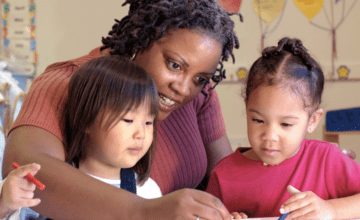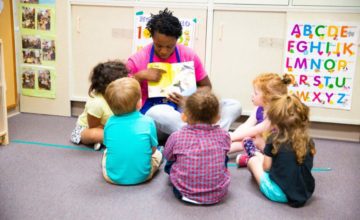Action-Oriented Activities
- Frogs on a Lily Pad
- Cut out big green circles from paper and scatter them across the floor. Suggest that your grandchild pretend to be a frog and hop from lily pad to lily pad. Don’t forget to “ribbit” together! Games like this build physical skills and coordination while encouraging imagination and creative thinking.
- Soaking Up Sponge Fun
- Grab some big sponges and get ready for some wet fun outside. You can toss a wet sponge to one another. You can also jump barefoot on a big soaking wet sponge to make the water come out. You might dip the sponge into a bucket of water and then squeeze it into a second bucket. How much water can you move from one bucket to the other? Activities like these help develop physical skills like hand-eye coordination. As with all water activities, it is critical to supervise children carefully as they play.
- Shadow Shapes
- On a sunny day, take your grandchild outside and show him his shadow. See if your child would like to make his shadow dance, jump, wave, crouch, run, and more. This is great practice for your grandchild’s listening skills and also gets him moving outside. For a final bit of fun, trace your grandchild’s shadow with chalk and together the two of you can color in his “shadow shape.”
- Marching Band
- Is the weather making it impossible to play outside? Instead, grab an instrument (rattle, bell, whistle, coffee can and spoon, etc.) for yourself and your grandchild, put on some wonderful marching music, and let your toddler lead you around the house in a musical parade.
Quiet Play Activities
- Match It Up
- Print out 10 pairs of matching pictures from the Internet or use a set of stickers. Glue or stick each picture onto an index card (you should have 10 pairs of matching pictures). Mix the pictures up and lay them face-up on the floor. Together with your grandchild, try to find matching pairs. This game teaches matching skills and turn-taking.
- Birthday Party for Teddy
- Find several stuffed animals and set them on a blanket on the floor. Have a “birthday party” with paper plates, cups, birthday hats, etc. You might even make a birthday cake for a Teddy using play-dough. What are the teddy bears doing at the party? What games do they like to play? Activities like this encourage your grandchild to use her imagination to create a pretend story.
- Painter Extraordinaire
- Pick up some inexpensive paintbrushes at an art or hardware store. Go outside and give your grandchild a small bowl of water and let him “paint” the sidewalk, the side of the house, the fence, his tricycle, or other outdoor toys, etc. Point out how the wet portion looks and feels different from the dry. As with any activity involving water, supervise your grandchild closely and dispose of all water when your child is done playing.
- I’m Puzzled
- Create a homemade puzzle for your grandchild by cutting a photo of a person, pet, or place that she is familiar with into 3 pieces. Laminate or cover each piece in clear contact paper to make it sturdy. See if your grandchild can put the pieces together again. (If this activity is difficult for her, you can provide a copy of the photo to use as a guide.) As your grandchild gets older, you can try cutting a 5×7 or 8×10 photo into 4, 5, or 6 pieces.
Activities That Build Thinking Skills
- Box It Up!
- Give your grandchild a big moving box and show her how a paper plate can become a steering wheel for a race car. Add aluminum foil along the sides of the box to make a rocket ship. Crumpled up newspaper on the bottom of the box can become water, a wrapping paper tube is a fishing pole, and the box is a boat. Games like this help your grandchild become a creative thinker and problem solver as she creates her own stories.
- Loud/Quiet Fill-n-Dump
- Take two plastic buckets. Encourage your grandchild to fill one of the buckets with plastic balls or bells (or other noisy objects) and the other with washcloths, scarves, or foam balls. As you fill up the bucket, talk about whether each one is loud or quiet. Now dump them! Which one is loud? Which one is quiet? This activity teaches your grandchild to sort objects. (You can play a variation of this game with big and little objects.)
- Open a Play-dough Pizzeria
- Use play-dough or homemade salt-dough to make a play-dough pizza, tacos, cookies, or cupcakes with your grandchild. See if your grandchild would like to pretend to serve you in a “restaurant” by putting the “pizza” on a paper plate and bringing it to you. Games like this build pretend play skills and help your grandchild develop muscles in his hands and fingers—which he’ll use for writing later on.
- Try the Two-Step
- Play a game where you give your grandchild two-step directions to follow, such as: “Get the ball and throw it to me” or “Run to the steps and then jump as high as you can.” As your grandchild approaches 3 years, try offering directions with three steps, “Get the ball, throw it to Grandpa, and then give Grandma a kiss.” This game builds your grandchild’s listening skills and is also a fun way to keep her active.
Activities That Build the Senses
- Indoor Leafbox
- Gather a plastic bin full of fall leaves. Talk about their shapes, colors, and sizes and about how they are the same or different. Then give your grandchild a bucket or plastic basin and let him fill and dump leaves, crumple them, and toss them. (Keep a small broom handy so he can help with clean-up.) This type of activity helps your grandchild begin to compare similar objects.
- Push a PomPom
- Wash out a margarine container and cut several circles out of the lid. Using pompoms (found at your local craft store), show your grandchild how she can push the pompoms through the holes. For children approaching 3 years, you can offer two different containers and pompoms in two different colors. Your grandchild can then try to sort them into the containers by color.
- That’s a Wrap!
- Let your wiggly toddler hop on bubble wrap (found at the post office or office supply store) to make “popping” noises. Unroll a length of bubble wrap or cut circles of bubble wrap and place in a line down the hall or across the room. Show your grandchild how he can hop on it to make it POP. Supervise closely to be sure your grandchild does not put the plastic in his mouth.
- Digging for Treasure
- Fill a packing box with shredded paper and hide a small toy for your grandchild to find—such as a small plastic dinosaur. Once your grandchild has found the item, let her hide it for you. (Your grandchild can also dig for treasure using other materials, such as Easter basket grass, sand, or dry coffee grounds—but supervise carefully.)
Activities That Build Language Skills
- A Few of My Favorite Things
- Ask your grandchild to show you his favorite toy, food, book, stuffed animal, etc. Snap a picture of him with each object, then glue each photo to an index card. Write on each card, “This is [child’s name]’s favorite book, toy, etc.” Tie the cards together to make a book. As you read the book together, point to your grandchild’s name on each page. This helps him make the link between the look of his name in print and the sound of his name when spoken.
- Picture It!
- Before you read a new book, take a “picture walk” with your grandchild and look at the illustrations first. See if your grandchild might want to tell you the story just using the pictures as a guide. This type of activity helps your grandchild develop her vocabulary, build creativity, and put actions in their logical order.
- Learning Body Parts
- Cut a photo from a magazine or catalog that shows a close-up of a child’s face and another that is a head-to-toe photo of a child or adult. Glue each to sturdy cardstock and cover with clear contact paper. When your grandchild has to wait (like at a restaurant or doctor’s office), take out the photos and ask him to “point to the baby’s nose” or “point to the lady’s leg.” By age 3, your grandchild may be able to name up to ten body parts.
- Sing-a-Long
- Singing is one of the easiest ways to learn new words; and grandparents often know lots of songs from their childhood that are perfect for sharing with toddlers. Songs are a wonderful way to continue long-lasting family traditions, and singing together is a fun way to build new memories with your grandchild




